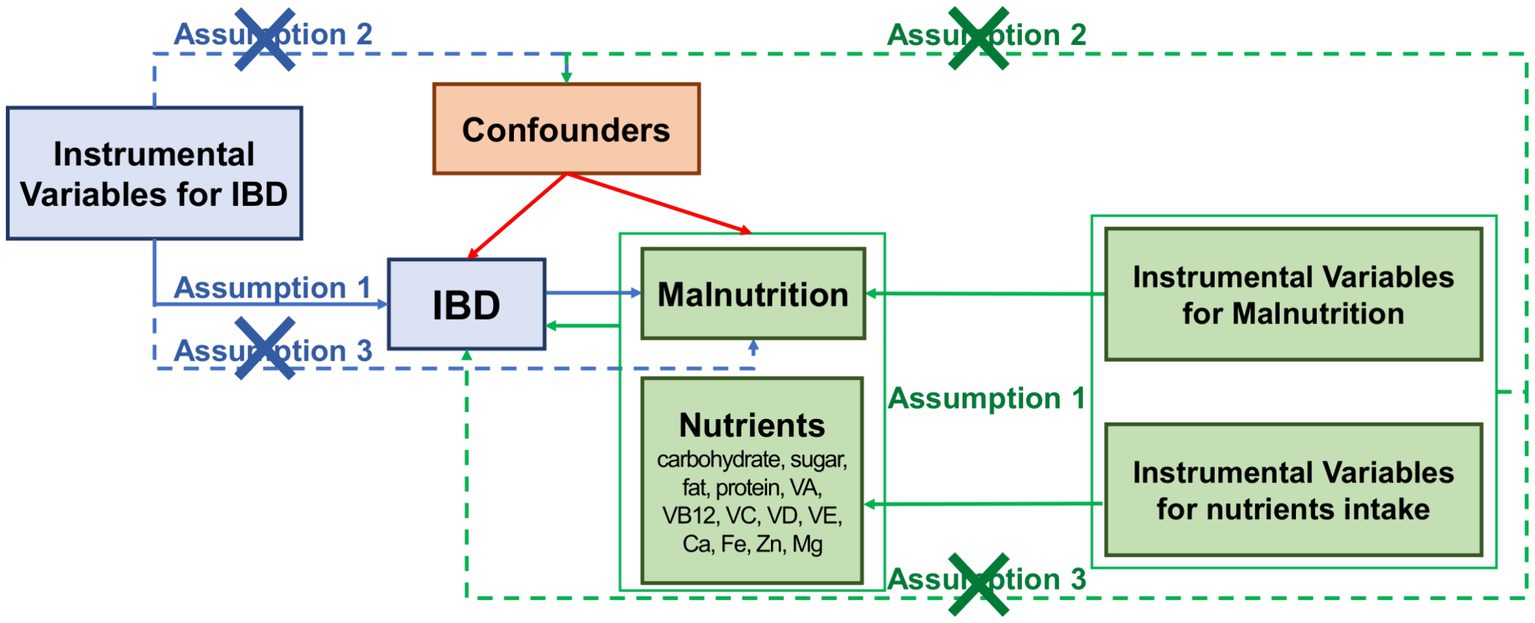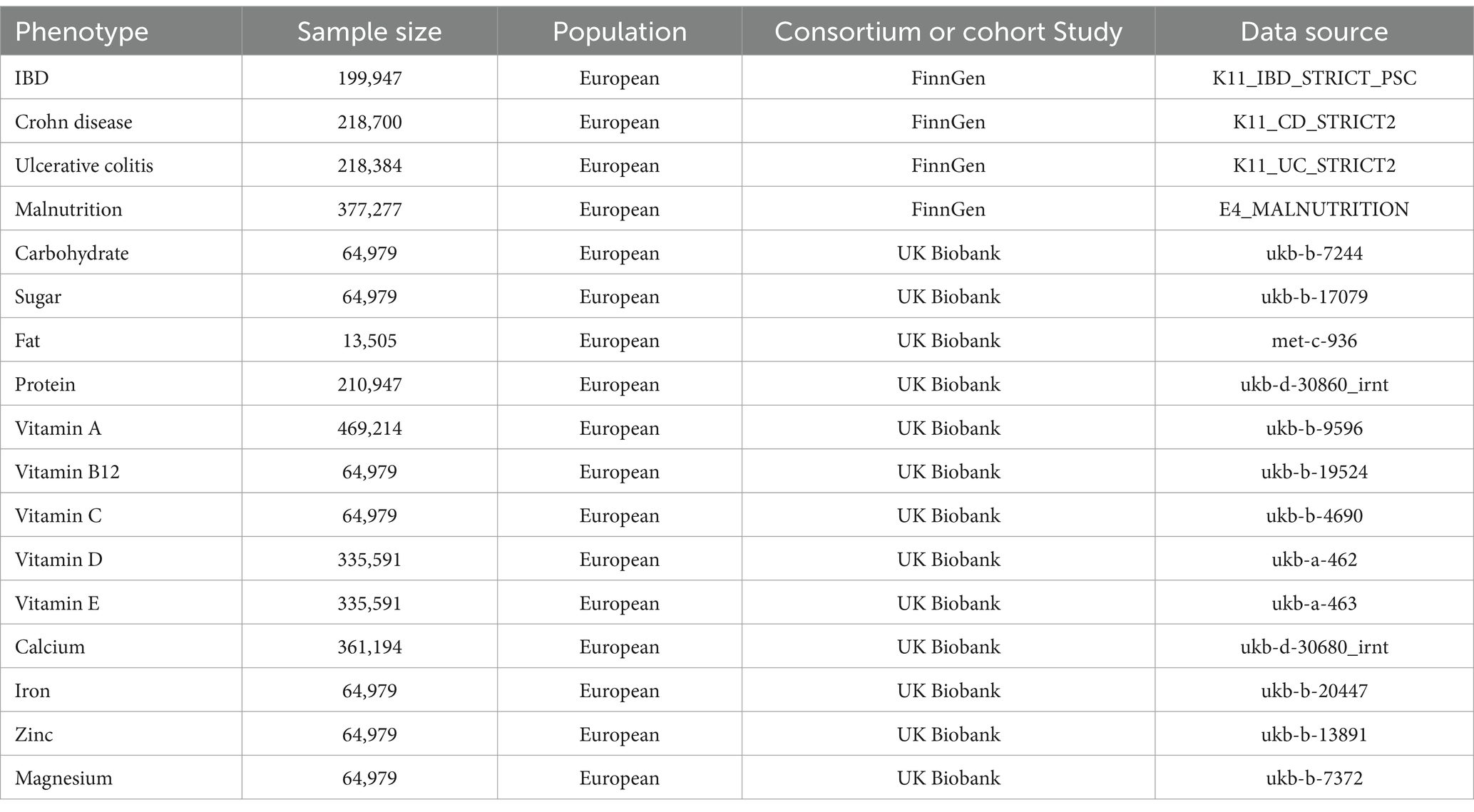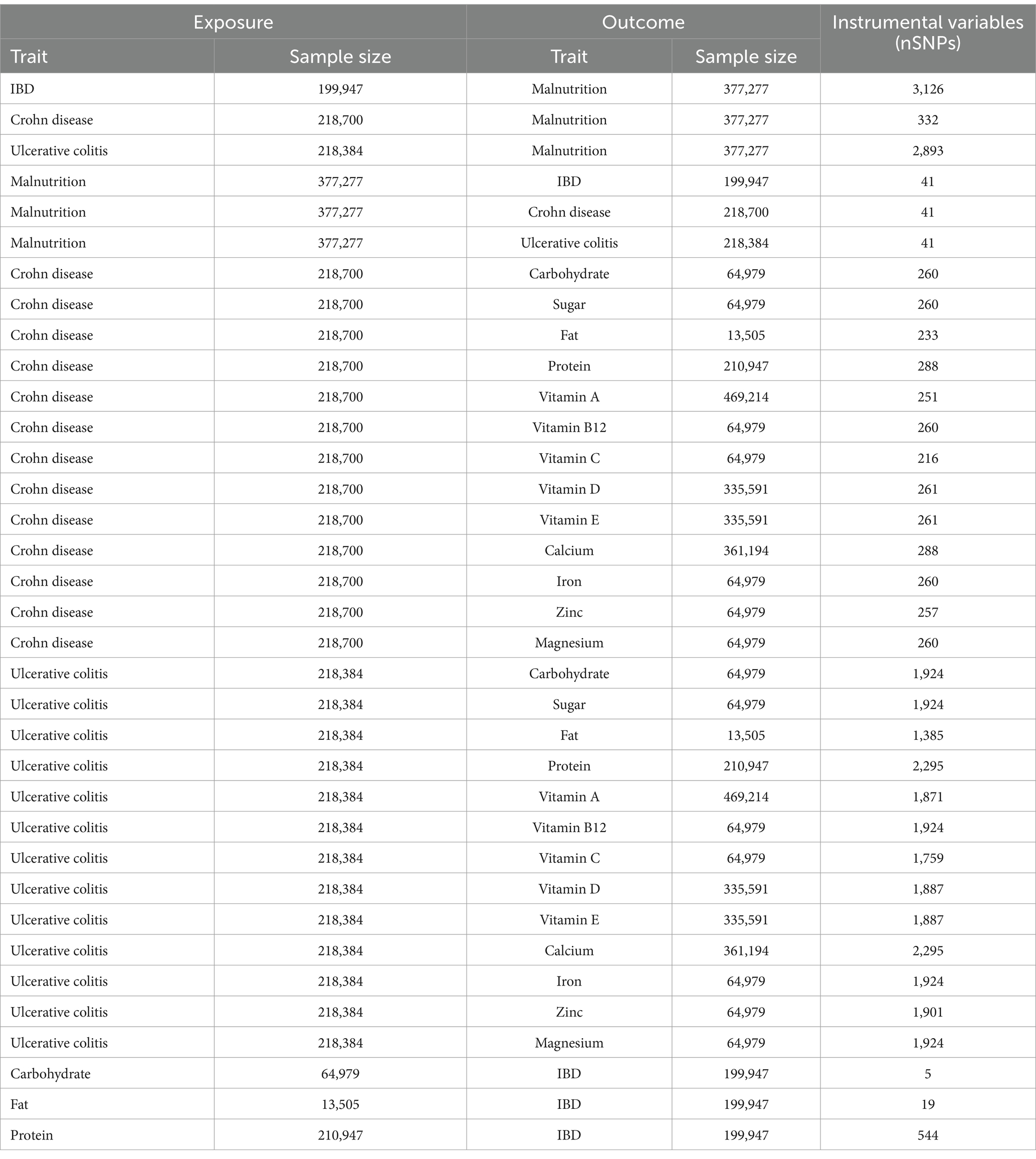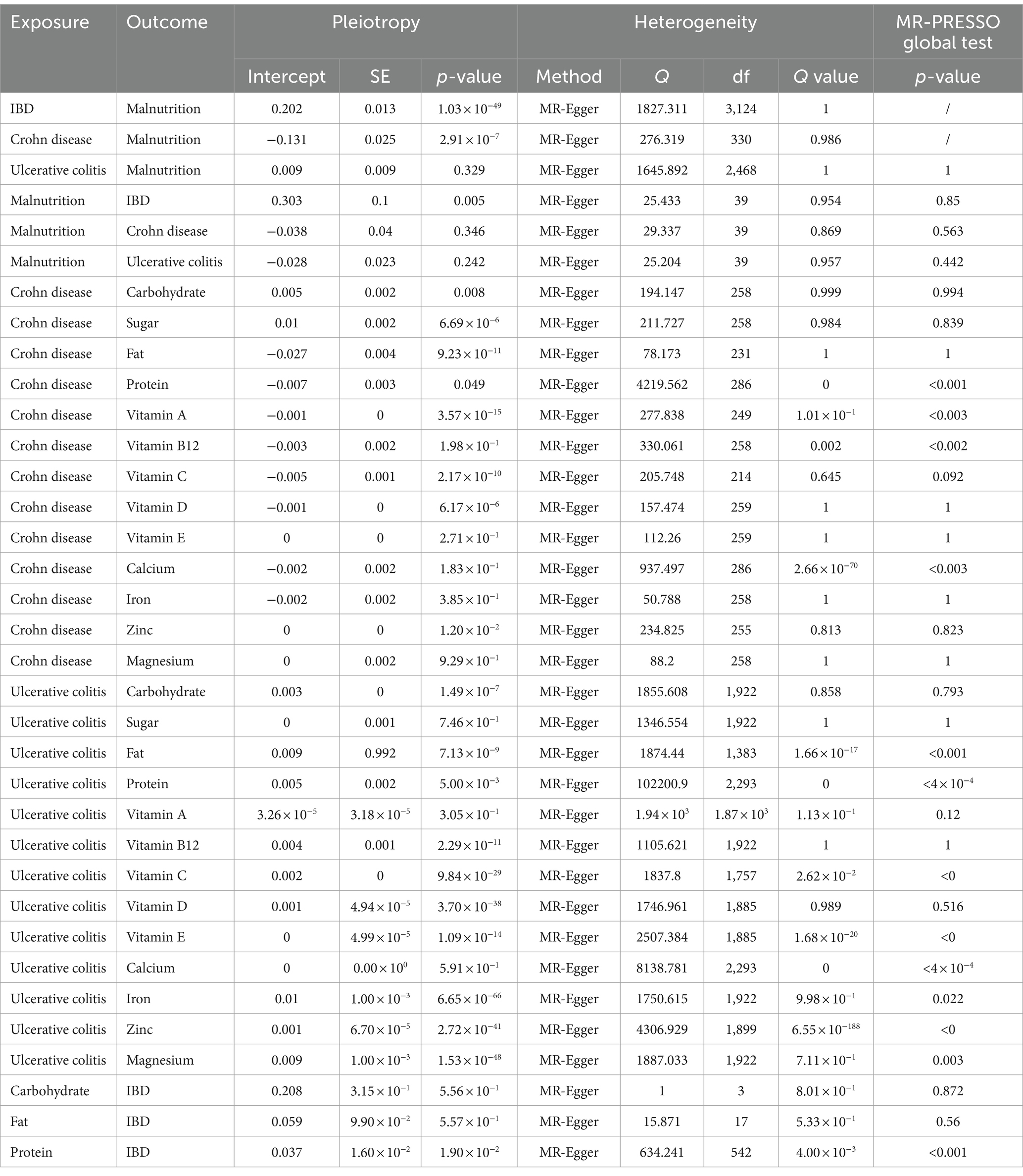- 1Department of Breast and Thyroid Surgery, Union Hospital, Tongji Medical College, Huazhong University of Science and Technology, Wuhan, China
- 2Department of Pediatric Surgery, Tongji Hospital, Tongji Medical College, Huazhong University of Science and Technology, Wuhan, China
- 3Tongji Medical College, Huazhong University of Science and Technology, Wuhan, China
- 4Health Management Center, Union Hospital, Tongji Medical College, Huazhong University of Science and Technology, Wuhan, China
Background: Malnutrition has emerged as main side effects of inflammatory bowel disease (IBD) which might also affect the prognosis of IBD. However, whether these associations are causal remains unclear. We aimed to identify the causality of IBD on malnutrition and explore the causal relationship of malnutrition and nutrients intake on IBD by using Mendelian randomization (MR).
Methods: Single nucleotide polymorphisms associated with IBD, malnutrition and nutrients intake were obtained from previous researches of genome-wide association studies (GWAS) (p < 0.00000005). MR analysis was conducted to evaluate the causality with different methods based on OR and their 95% CIs. Meanwhile, heterogeneity, pleiotropy and MR-PRESSO were used for instrumental variables evaluation.
Results: The results of MR analysis revealed that IBD, both Crohn disease (CD) and ulcerative colitis (UC), could directly impact the incidence of malnutrition (p-value <0.01). CD is directly related to nutrients such as sugar, fat, VA, VC, VD and zinc, while UC is correlated with carbohydrate, fat, VB12, VC, VD, VE, iron, zinc and magnesium. However, our results suggested that malnutrition could not affect the risk of IBD directly (p > 0.05). Further analysis showed similar results that nutrients intake had no direct effect on IBD, neither CD or UC.
Conclusion: Our results indicated that IBD increases the risk of malnutrition, however, malnutrition and nutrients intake might not directly affect the progression of IBD.
Introduction
Inflammatory bowel disease (IBD) is a chronic, relapsing inflammatory gastrointestinal disorder comprising two primary forms, namely Crohn’s disease (CD) and ulcerative colitis (UC) (1). Clinical manifestations of IBD include abdominal pain, diarrhea, rectal bleeding, and weight loss (2). IBD is a multifactorial disease, and its pathogenesis remains unclear. Abnormal immune responses mediated within the intestinal microenvironment, microbiota, and genetic factors play pivotal roles in the development of IBD (3). Current understanding of the etiology of IBD dictates that management primarily revolves around anti-inflammatory and immunosuppressive strategies (4, 5).
Malnutrition was diagnosed based on Global Leadership Initiative on Malnutrition (GLIM) criteria (phenotypic criteria include unintentional weight loss, low BMI and low muscle mass) (6). IBD patients often exhibit reduced food intake, malabsorption, dysbiosis, and increased energy expenditure as a result of immune-inflammatory reactions, contributing to the development of malnutrition (7). More than 70% of hospitalized patients present symptoms of weight loss. Furthermore, poor nutritional status is closely linked to an unfavorable prognosis and inadequate response to treatment. Therefore, the assessment of nutritional status and the provision of appropriate nutritional support are vital components of the clinical treatment process (8, 9). While malnutrition in IBD patients may stem from various factors, and enhancing nutritional status is a crucial aspect of clinical care, the involvement of malnutrition in the pathogenesis of IBD remains uncertain (10, 11). Similarly, the potential impact of nutrient intake on the progression or remission of IBD necessitates further exploration.
Conventional observational epidemiological research methods are vulnerable to confounding factors and the possibility of reverse causation (12). Furthermore, prospective studies often entail substantial time and financial investments (13). Mendelian randomization (MR) represents an analytical technique utilized to deduce causal relationships between exposure factors and outcomes by leveraging genetic variations linked to the exposure factor (14, 15). Through the random assignment of alleles of these genetic variations, MR minimizes the influence of reverse causation and other confounding factors, thereby offering a significant reduction in the impact of such factors (16). This approach has garnered considerable attention in recent years.
In this study, we identified relevant genetic variations and performed a MR analysis to explore the reciprocal relationships between malnutrition and IBD (CD and UC). Furthermore, we conducted additional analyses to examine the links between essential nutritional components (carbohydrate, sugar, fat, protein, vitamin A, vitamin B12, vitamin C, vitamin D, vitamin E, calcium, iron, zinc and magnesium) and IBD (CD and UC). Our aim is that this study will potentially lay the groundwork for advancing the clinical management of IBD.
Materials and methods
Study design
MR analysis assumes the distribution of gene variants in the population is random and these gene variants only influence the outcomes through the pathway of exposure factors and are not affected by other confounding factors. Figure 1 showed the flow chart of our study. Our MR study designed also followed the STROBE-MR statement and firstly examined the bidirectional associations between malnutrition and IBD (CD and UC). Meanwhile, the relationship between different nutrients (carbohydrate, sugar, fat, protein, vitamin A, vitamin B12, vitamin C, vitamin D, vitamin E, calcium, iron, zinc, magnesium) and IBD were also discussed.
Data collection
The datasets our study involved were taken from publicly available GWAS (17, 18). SNPs associated with malnutrition and IBD were screened from GWAS meta-analysis. Single-nucleotide polymorphisms (SNPs) of nutrient elements were extracted from biobank (19). Detailed information of data used in our study is displayed in Table 1.
Instrument variants selection
Quality control techniques were conducted to screen instrument variants satisfying the first assumption. Meanwhile, independent SNPs were selected with p-value <5 × 10−8 and r2 < 0.001 to exclude linkage disequilibrium. All instrument variants are listed in Table 2.
Statistical analysis
The MR analysis was conducted by “TwoSampleMR” and “MRPRESSO” packages. The inverse variance weighted (IVW) method was used as the primary analysis method and maximum likelihood, MR-Egger and weighted median methods were complementary. The association of malnutrition with IBD was assessed by combining beta values and standard errors. Besides, MR heterogeneity and pleiotropy test were evaluated by MR-Egger and MR-pleiotropy.
Results
Causal effects of IBD on malnutrition
The results of MR analysis demonstrated the causal effect of IBD on malnutrition in all method which were presented in Figure 2A and these related SNPs were shown in Figure 2B. The scatter and funnel plot were also displayed in Figures 2C,D. Meanwhile, no heterogeneity (p-value >0.05) was found by Cochran’s Q test (Table 3). MR-Egger regression method detected directional pleiotropy (Intercept = 0.202, p-value = 1.026 × 10−49) (Table 3). Although MR-PRESSO analysis was not applicable for this data set, it would not have significant impacts on the conclusion that IBD is the risk factor of malnutrition. Moreover, the causal relationship of CD, UC on malnutrition were also revealed (Figures 2E–H). In addition, the relationship of CD, UC and malnutrition was also shown in scatter and funnel plots (Supplementary Figures S1A–D).
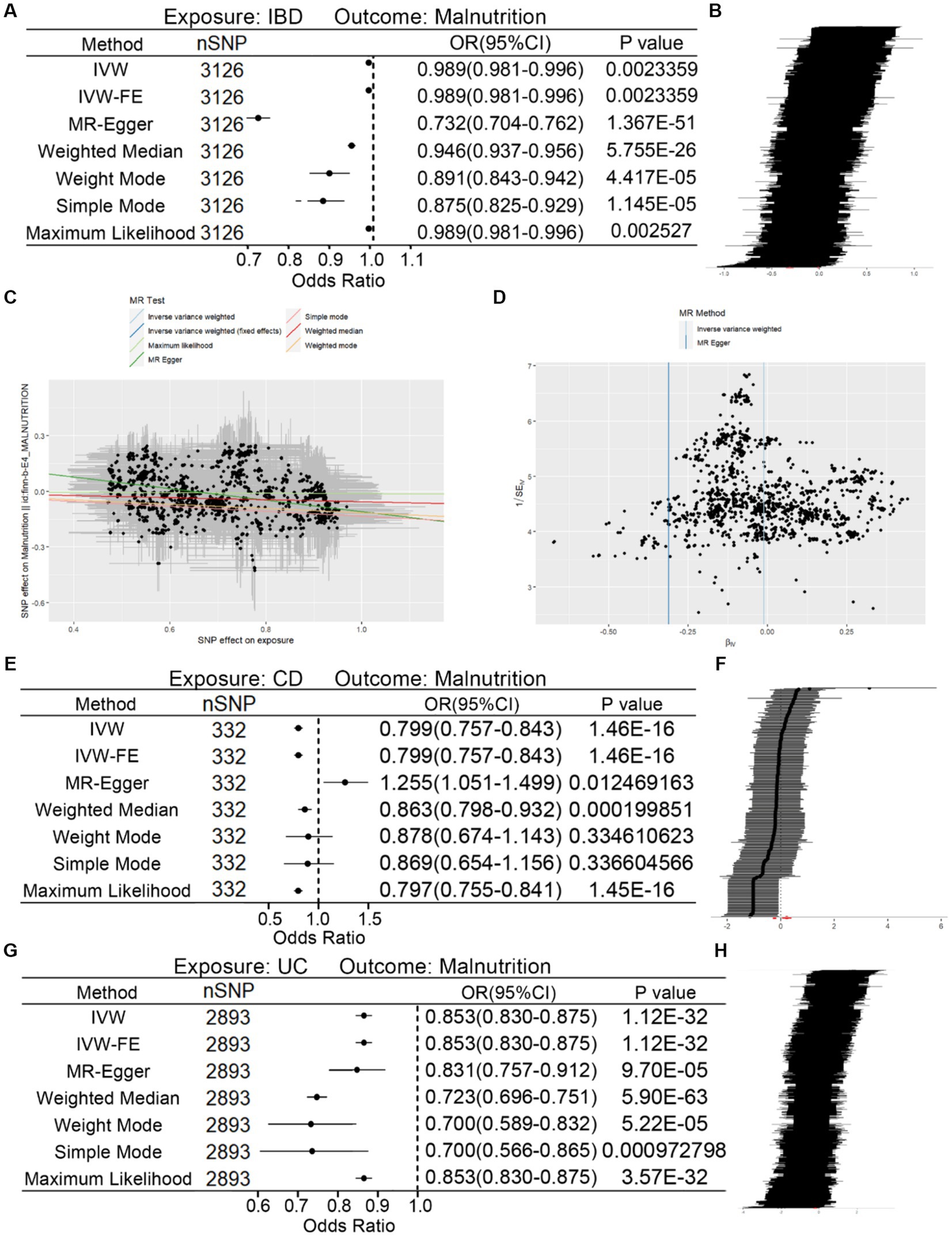
Figure 2. Associations of genetic predicted IBD instrumental variables with malnutrition. (A) Forest plot of causal relationship of IBD on malnutrition with different methods. (B) Sensitivity analysis of the association of IBD on malnutrition represented by SNPs. (C,D) Scatter plot and funnel plot of causality of IBD on malnutrition. (E) Forest plot of causal relationship of CD on malnutrition with different methods. (F) Sensitivity analysis of the association of CD on malnutrition represented by SNPs. (G) Forest plot of causal relationship of UC on malnutrition with different methods. (H) Sensitivity analysis of the association of UC on malnutrition represented by SNPs.
Causal effects of CD, UC on nutrient elements
In addition, we also evaluated the causal effects of CD and UC on nutrient elements. We found that CD had a direct impact on the body’s nutrients level such as sugar, fat vitamin A, vitamin C, vitamin D and zinc (Figure 3A). Furthermore, UC could directly influence the level of carbohydrate, sugar, fat, vitamin B12, vitamin C, vitamin D, vitamin E, iron, zinc and magnesium (Figure 3B).
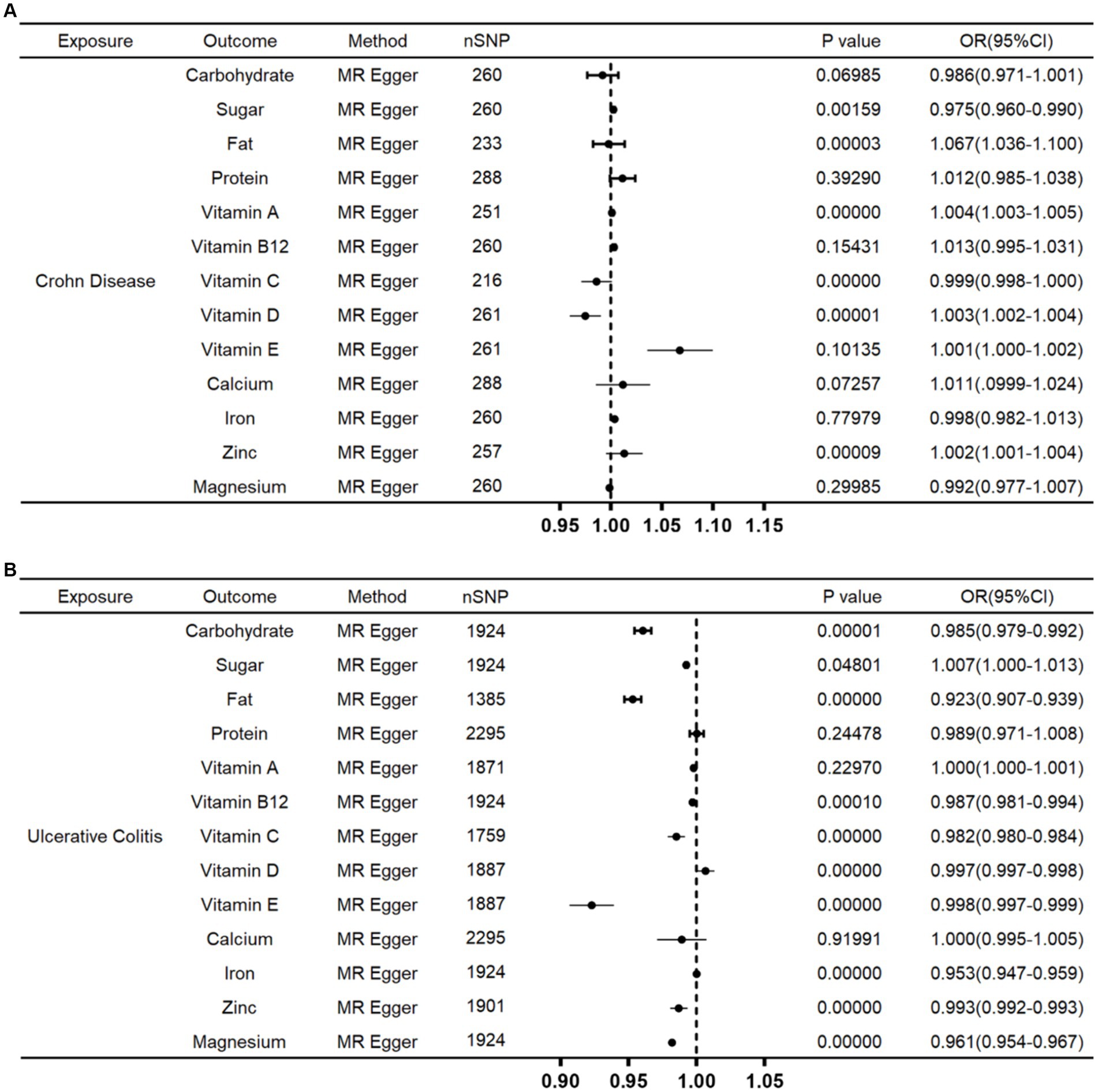
Figure 3. Associations of genetically instrumental variables predicting relationship of CD and UC on nutrient elements. (A) Forest plot of causal relationship of CD on nutrient elements. (B) Forest plot of causal relationship of UC on nutrient elements.
Causal effects of malnutrition on IBD
After synthesizing the results of various methods, we indicated that there was no causal relationship for malnutrition to IBD (Figures 4A,B). The scatter and funnel plot were also displayed in Figures 4C,D. Besides, no heterogeneity (p-value >0.05) was found but directional pleiotropy (Intercept = 0.303, p-value = 0.005) was detected (Table 3). After eliminating outliers, results of MR-PRESSO analysis showed no directional pleiotropy remained (Table 3). After that, we also analyzed the causal effects of malnutrition on CD and UC. Similarly, malnutrition could not directly lead to CD or UC (Figures 4E–H). The scatter and funnel plots were shown in Supplementary Figures S2A–D.
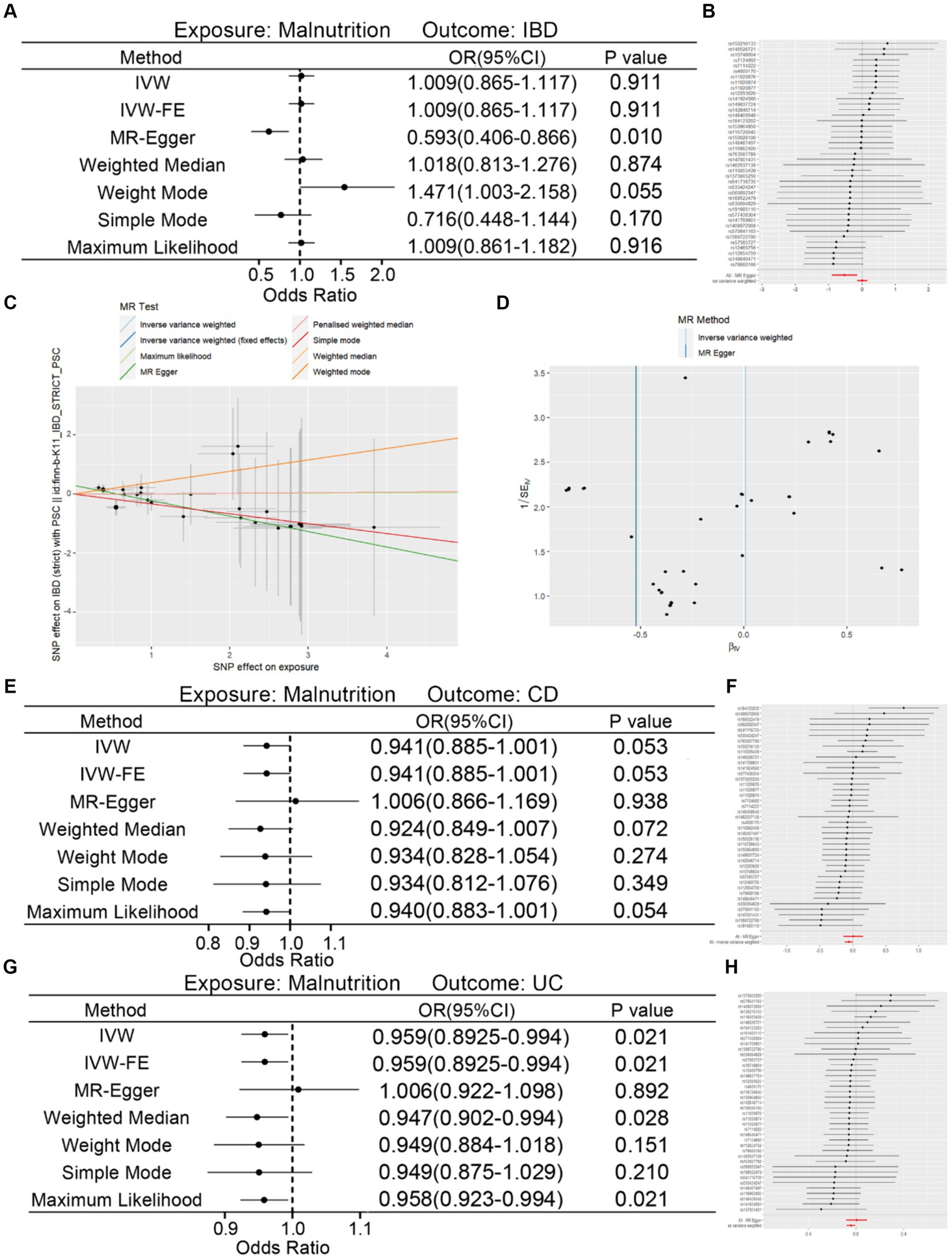
Figure 4. Associations of genetically instrumental variables predicting relationship of malnutrition on IBD. (A) Forest plot of causal relationship of malnutrition on IBD with different methods. (B) Sensitivity analysis of the association of malnutrition on IBD represented by SNPs. (C,D) Scatter plot and funnel plot of causality of malnutrition on IBD. (E) Forest plot of causal relationship of malnutrition on CD with different methods. (F) Sensitivity analysis of the association of malnutrition on CD represented by SNPs. (G) Forest plot of causal relationship of malnutrition on UC with different methods. (H) Sensitivity analysis of the association of malnutrition on UC represented by SNPs.
Causal effects of nutrients intake on IBD
Finally, the causal relationship of major nutrients intake (carbohydrate, fat, protein) on IBD was also evaluated and the results of MR analysis revealed that these three nutrients intake were not associated with IBD (Figures 5A,C,E). The Cochran’s Q test showed that heterogeneity only existed between protein and IBD (p-value <0.05) and the other two showed no heterogeneity with IBD (Table 3). Similarly, directional pleiotropy existed only between protein and IBD (Table 3). Through outliers removement and MR-PRESSO analysis, the pleiotropy of protein on IBD has not been eliminated (Table 3). Furthermore, risk of SNPs among different instrumental variables were shown in Figures 5B,D,F. Finally, the causal relationship, scatter and funnel plots of nutrients intake on IBD were also shown (Supplementary Figures S3A–F).
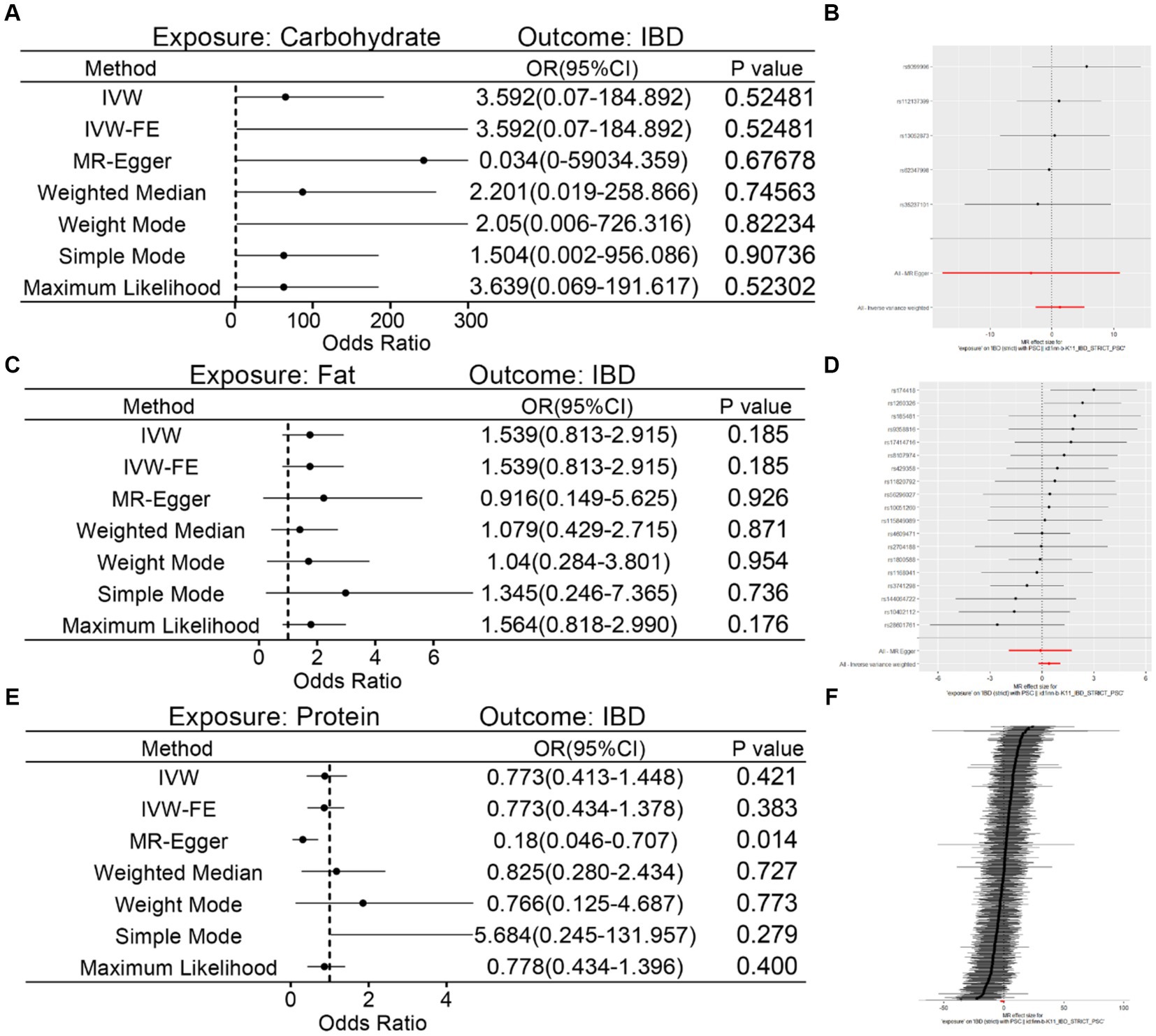
Figure 5. MR analysis of causal relationship of nutrients intake on IBD. (A,B) Detailed causality of carbohydrate intake on IBD. (C,D) Detailed causality of fat intake on IBD. (E,F) Detailed causality of protein intake on IBD.
Discussion
This study firstly investigated the causal relationship between malnutrition, nutrients intake and IBD. Through MR analysis, we ultimately concluded that IBD is likely to increase the risk of malnutrition, which was consistent with the conclusions of previous clinical researches. Meanwhile, we failed to find compelling evidence that genetically predicted the causal relationship of malnutrition and nutrients intake to IBD.
The correlation between malnutrition and the risk of IBD has been reported previously by epidemiological observations (20). Due to the long-term course of disease, IBD patients usually experience loss of appetite and reduced food intake (21). Besides, glucocorticoids and sulfasalazine treatment could also result in malabsorption of nutrients, nausea and anemia (22). Meanwhile, diarrhea and vomiting further reduce nutrients intake. In addition, prolonged inflammatory state and imbalance of intestinal flora homeostasis seriously affect intestinal digestion and absorption. After that, long-term state of unhealthy and abnormal immune response aggravates energy consumption. Finally, prolonged restrictive diet management would also lead to a significant reduction of nutrients intake. Combined with these reasons mentioned above, there are sufficient grounds to reach the conclusion that IBD could increase the risk of malnutrition (7).
Our MR analysis demonstrated the same causal relationship of IBD on malnutrition. The results revealed several SNPs directly associated with IBD and malnutrition, which supported that multiple pathways were involved in the pathogenesis of IBD induced malnutrition. Besides, both CD and UC could result in malnutrition. These results are consistent with the results of clinical study.
Interestingly, several nutrient elements were found to be directly correlated with IBD, such as fat, vitamin C, vitamin D and minerals (iron, zinc). Previous research has indicated that fat distribution of viscera was valuable for subtype distinguish of IBD (23). Long chain fatty acid intake might potentially increase the risk of colitis, which were not found in our research (24). Besides, clinical study also found a widespread decrease of VC in blood samples from IBD patients, which was consistent with results of MR analysis (25). Another research has elaborated the application value of Vitamin Din the treatment of autoimmune diseases, especially IBD (26).
In addition, nutritional support therapy is receiving increasing attention in clinical practice of IBD (27). Recently, many researches have discussed the role of nutritional support in the treatment of IBD and it has been included in relevant diagnosis and treatment guidelines (11, 28, 29). Precise dietary management were found to improve disease activity and prolong relapse interval to some extent, however, the specific clinical value and mechanism of diet management in the treatment of IBD remains unclear (30, 31).
Due to the limitation of observational research methods and the difficulty of clinical implementation of prospective studies, our study used SNPs specifically related to exposure or outcome as instrumental variables to evaluate the causal relationship of malnutrition and nutrients intake on the risk of IBD. To our surprise, the results were inconsistent with clinical experience: (1) malnutrition could not increase the risk of IBD; (2) intake of carbohydrate, fat and protein had no effect on the occurrence of IBD. We speculated that nutritional status and nutrients intake might not directly affect the progression of IBD. Firstly, nutritional support therapy is mostly decided based on the nutritional status of IBD patients. Clinical nutritional support is expected to restore the immune capacity of IBD patients and supplement the nutritional loss in the course of disease to a certain extent. Malnutrition may not have a direct effect on IBD. Similarly, the effects of nutrients intake on IBD might also be indirect. Due to the characteristics of MR analysis, mediated SNPs may have been filtered out at the beginning of our analysis, which requires further researches. Nutritional status might affect IBD through improving the immune level, regulating the homeostasis of intestinal flora and protecting the normal function of intestinal tract. Certainly, the mechanism that SNPs that mediated directly with malnutrition identified in this research remains further exploration.
Conclusion
The result of our MR analysis strongly supports the clinical findings that IBD (both CD and UC) is causally related to risk of malnutrition but there is insufficient evidence to suggest that malnutrition and nutrients intake have direct effects on IBD.
Data availability statement
The original contributions presented in the study are included in the article/Supplementary material, further inquiries can be directed to the corresponding authors.
Author contributions
SW: Formal analysis, Methodology, Software, Funding acquisition, Writing – original draft. JW: Conceptualization, Formal analysis, Methodology, Software, Writing – original draft. XM: Conceptualization, Formal analysis, Methodology, Software, Writing – original draft. SY: Data curation, Visualization, Writing – review & editing. LW: Data curation, Writing – review & editing. KC: Data curation, Writing – review & editing. ZL: Data curation, Writing – review & editing. JX: Data curation, Writing – review & editing. XY: Data curation, Writing – review & editing. XC: Data curation, Writing – review & editing. JF: Funding acquisition, Project administration, Resources, Supervision, Validation, Writing – review & editing. RG: Funding acquisition, Project administration, Resources, Supervision, Validation, Writing – review & editing.
Funding
The author(s) declare that financial support was received for the research, authorship, and/or publication of this article. This work was supported by the National Natural Science Foundation of China (81873541, 82071685, and 82201904) and Natural Science Foundation of Hubei (2023AFB397).
Conflict of interest
The authors declare that the research was conducted in the absence of any commercial or financial relationships that could be construed as a potential conflict of interest.
Publisher’s note
All claims expressed in this article are solely those of the authors and do not necessarily represent those of their affiliated organizations, or those of the publisher, the editors and the reviewers. Any product that may be evaluated in this article, or claim that may be made by its manufacturer, is not guaranteed or endorsed by the publisher.
Supplementary material
The Supplementary material for this article can be found online at: https://www.frontiersin.org/articles/10.3389/fnut.2024.1406733/full#supplementary-material
Abbreviations
IBD, Inflammatory bowel disease; MR, Mendelian randomization; GWAS, Genome-wide association studies; SNPs, Single-nucleotide polymorphisms
References
1. Kaplan, GG . The global burden of IBD: from 2015 to 2025. Nat Rev Gastroenterol Hepatol. (2015) 12:720–7. doi: 10.1038/nrgastro.2015.150
2. Rogler, G, Singh, A, Kavanaugh, A, and Rubin, DT. Extraintestinal manifestations of inflammatory bowel disease: current concepts, treatment, and implications for disease management. Gastroenterology. (2021) 161:1118–32. doi: 10.1053/j.gastro.2021.07.042
3. Xavier, RJ, and Podolsky, DK. Unravelling the pathogenesis of inflammatory bowel disease. Nature. (2007) 448:427–34. doi: 10.1038/nature06005
4. Jeong, DY, Kim, S, Son, MJ, Son, CY, Kim, JY, Kronbichler, A, et al. Induction and maintenance treatment of inflammatory bowel disease: a comprehensive review. Autoimmun Rev. (2019) 18:439–54. doi: 10.1016/j.autrev.2019.03.002
5. Sasson, AN, Ananthakrishnan, AN, and Raman, M. Diet in treatment of inflammatory bowel diseases. Clin Gastroenterol Hepatol. (2021) 19:425–35.e3. doi: 10.1016/j.cgh.2019.11.054
6. Cederholm, T, Jensen, GL, Correia, M, Gonzalez, MC, Fukushima, R, Higashiguchi, T, et al. GLIM criteria for the diagnosis of malnutrition—a consensus report from the global clinical nutrition community. Clin Nutr. (2019) 38:1–9. doi: 10.1016/j.clnu.2018.08.002
7. Massironi, S, Viganò, C, Palermo, A, Pirola, L, Mulinacci, G, Allocca, M, et al. Inflammation and malnutrition in inflammatory bowel disease. Lancet Gastroenterol Hepatol. (2023) 8:579–90. doi: 10.1016/S2468-1253(23)00011-0
8. Cucinotta, U, Romano, C, and Dipasquale, V. Diet and nutrition in pediatric inflammatory bowel diseases. Nutrients. (2021) 13:655. doi: 10.3390/nu13020655
9. Fitzpatrick, JA, Melton, SL, Yao, CK, Gibson, PR, and Halmos, EP. Dietary management of adults with IBD—the emerging role of dietary therapy. Nat Rev Gastroenterol Hepatol. (2022) 19:652–69. doi: 10.1038/s41575-022-00619-5
10. Gecse, KB, and Lakatos, PL. IBD in 2016: biologicals and biosimilars in IBD—the road to personalized treatment. Nat Rev Gastroenterol Hepatol. (2017) 14:74–6. doi: 10.1038/nrgastro.2016.206
11. Bischoff, SC, Bager, P, Escher, J, Forbes, A, Hébuterne, X, Hvas, CL, et al. ESPEN guideline on clinical nutrition in inflammatory bowel disease. Clin Nutr. (2023) 42:352–79. doi: 10.1016/j.clnu.2022.12.004
12. Ruxton, C . Interpretation of observational studies: the good, the bad and the sensational. Proc Nutr Soc. (2022) 81:279–87. doi: 10.1017/S0029665122000775
13. Schober, P, and Vetter, TR. Confounding in observational research. Anesth Analg. (2020) 130:635. doi: 10.1213/ANE.0000000000004627
14. Sekula, P, Del Greco, MF, Pattaro, C, and Köttgen, A. Mendelian randomization as an approach to assess causality using observational data. J Am Soc Nephrol. (2016) 27:3253–65. doi: 10.1681/ASN.2016010098
15. Skrivankova, VW, Richmond, RC, Woolf, BAR, Yarmolinsky, J, Davies, NM, Swanson, SA, et al. Strengthening the reporting of observational studies in epidemiology using Mendelian randomization: the STROBE-MR statement. JAMA. (2021) 326:1614–21. doi: 10.1001/jama.2021.18236
16. Burgess, S, and Thompson, SG. Interpreting findings from Mendelian randomization using the MR-Egger method. Eur J Epidemiol. (2017) 32:377–89. doi: 10.1007/s10654-017-0255-x
17. Kurki, MI, Karjalainen, J, Palta, P, Sipilä, TP, Kristiansson, K, Donner, KM, et al. FinnGen provides genetic insights from a well-phenotyped isolated population. Nature. (2023) 613:508–18. doi: 10.1038/s41586-022-05473-8
19. Perez-Cornago, A, Pollard, Z, Young, H, van Uden, M, Andrews, C, Piernas, C, et al. Description of the updated nutrition calculation of the Oxford WebQ questionnaire and comparison with the previous version among 207,144 participants in UK Biobank. Eur J Nutr. (2021) 60:4019–30. doi: 10.1007/s00394-021-02558-4
20. Balestrieri, P, Ribolsi, M, Guarino, MPL, Emerenziani, S, Altomare, A, and Cicala, M. Nutritional aspects in inflammatory bowel diseases. Nutrients. (2020) 12:372. doi: 10.3390/nu12020372
21. Day, AS, Yao, CK, Costello, SP, Andrews, JM, and Bryant, RV. Food avoidance, restrictive eating behaviour and association with quality of life in adults with inflammatory bowel disease: a systematic scoping review. Appetite. (2021) 167:105650. doi: 10.1016/j.appet.2021.105650
22. Stein, J, Hartmann, F, and Dignass, AU. Diagnosis and management of iron deficiency anemia in patients with IBD. Nat Rev Gastroenterol Hepatol. (2010) 7:599–610. doi: 10.1038/nrgastro.2010.151
23. Xiong, Z, Wu, P, Zhang, Y, Chen, J, Shen, Y, Kamel, I, et al. Radiological biomarkers reflecting visceral fat distribution help distinguish inflammatory bowel disease subtypes: a multicenter cross-sectional study. Insights Imaging. (2024) 15:70. doi: 10.1186/s13244-024-01640-9
24. Wei, Y, Li, J, Li, J, Liu, C, Guo, X, Liu, Z, et al. Dietary long-chain fatty acids promote colitis by regulating palmitoylation of STAT3 through CD36-mediated endocytosis. Cell Death Dis. (2024) 15:60. doi: 10.1038/s41419-024-06456-5
25. Brownson, E, Saunders, J, Jatkowska, A, White, B, Gerasimidis, K, Seenan, JP, et al. Micronutrient status and prediction of disease outcome in adults with inflammatory bowel disease receiving biologic therapy. Inflamm Bowel Dis. (2023) 30:1233–40. doi: 10.1093/ibd/izad174
26. Murdaca, G, Greco, M, Borro, M, and Gangemi, S. Hygiene hypothesis and autoimmune diseases: a narrative review of clinical evidences and mechanisms. Autoimmun Rev. (2021) 20:102845. doi: 10.1016/j.autrev.2021.102845
27. Dua, A, Corson, M, Sauk, JS, Jaffe, N, and Limketkai, BN. Impact of malnutrition and nutrition support in hospitalised patients with inflammatory bowel disease. Aliment Pharmacol Ther. (2023) 57:897–906. doi: 10.1111/apt.17389
28. Torres, J, Bonovas, S, Doherty, G, Kucharzik, T, Gisbert, JP, Raine, T, et al. ECCO guidelines on therapeutics in Crohn’s disease: medical treatment. J Crohns Colitis. (2020) 14:4–22. doi: 10.1093/ecco-jcc/jjz180
29. Lamb, CA, Kennedy, NA, Raine, T, Hendy, PA, Smith, PJ, Limdi, JK, et al. British Society of Gastroenterology consensus guidelines on the management of inflammatory bowel disease in adults. Gut. (2019) 68:s1–s106. doi: 10.1136/gutjnl-2019-318484
30. Narula, N, Dhillon, A, Zhang, D, Sherlock, ME, Tondeur, M, and Zachos, M. Enteral nutritional therapy for induction of remission in Crohn’s disease. Cochrane Database Syst Rev. (2018) 4:CD000542. doi: 10.1002/14651858.CD000542.pub3
Keywords: malnutrition, nutrients intake, inflammatory bowel disease, Mendelian randomization, GWAS
Citation: Wang S, Wang J, Meng X, Yang S, Wu L, Chen K, Li Z, Xiao J, Yu X, Chen X, Feng J and Gong R (2024) Exploring causal association between malnutrition, nutrients intake and inflammatory bowel disease: a Mendelian randomization analysis. Front. Nutr. 11:1406733. doi: 10.3389/fnut.2024.1406733
Edited by:
Raffaele Pellegrino, University of Campania Luigi Vanvitelli, ItalyReviewed by:
Giuseppe Murdaca, University of Genoa, ItalyVivek P. Chavda, LM College of Pharmacy, India
Copyright © 2024 Wang, Wang, Meng, Yang, Wu, Chen, Li, Xiao, Yu, Chen, Feng and Gong. This is an open-access article distributed under the terms of the Creative Commons Attribution License (CC BY). The use, distribution or reproduction in other forums is permitted, provided the original author(s) and the copyright owner(s) are credited and that the original publication in this journal is cited, in accordance with accepted academic practice. No use, distribution or reproduction is permitted which does not comply with these terms.
*Correspondence: Jiexiong Feng, ZmVuZ2ppZXhpb25nQHRqaC50am11LmVkdS5jbg==; Rui Gong, Z29uZ3J1aUBodXN0LmVkdS5jbg==
†These authors have contributed equally to this work and share first authorship
 Shi Wang1†
Shi Wang1† Xinyao Meng
Xinyao Meng Ke Chen
Ke Chen Jun Xiao
Jun Xiao Xuyong Chen
Xuyong Chen Jiexiong Feng
Jiexiong Feng